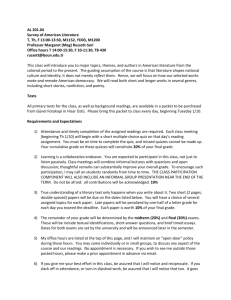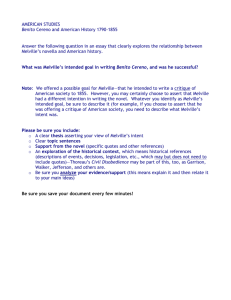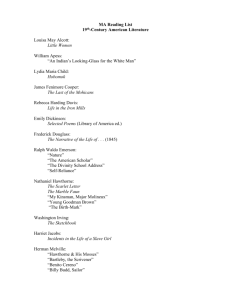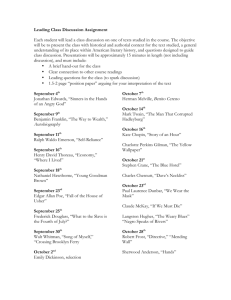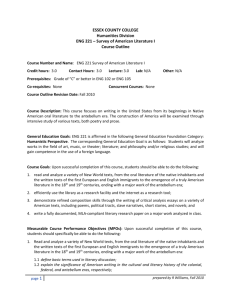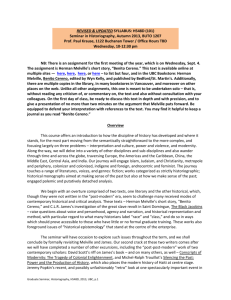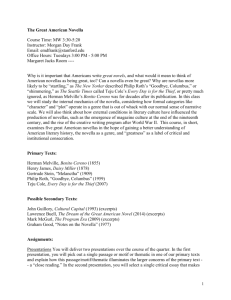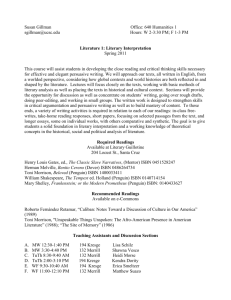Herman Melville Discussion Questions
advertisement
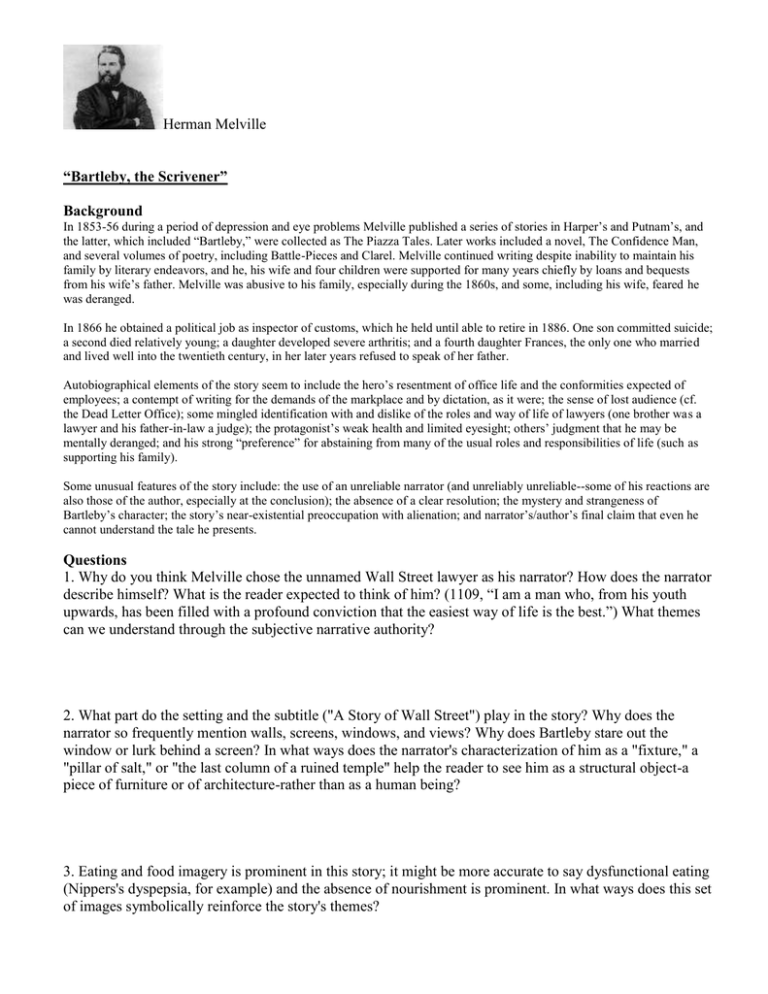
Herman Melville “Bartleby, the Scrivener” Background In 1853-56 during a period of depression and eye problems Melville published a series of stories in Harper’s and Putnam’s, and the latter, which included “Bartleby,” were collected as The Piazza Tales. Later works included a novel, The Confidence Man, and several volumes of poetry, including Battle-Pieces and Clarel. Melville continued writing despite inability to maintain his family by literary endeavors, and he, his wife and four children were supported for many years chiefly by loans and bequests from his wife’s father. Melville was abusive to his family, especially during the 1860s, and some, including his wife, feared he was deranged. In 1866 he obtained a political job as inspector of customs, which he held until able to retire in 1886. One son committed suicide; a second died relatively young; a daughter developed severe arthritis; and a fourth daughter Frances, the only one who married and lived well into the twentieth century, in her later years refused to speak of her father. Autobiographical elements of the story seem to include the hero’s resentment of office life and the conformities expected of employees; a contempt of writing for the demands of the markplace and by dictation, as it were; the sense of lost audience (cf. the Dead Letter Office); some mingled identification with and dislike of the roles and way of life of lawyers (one brother was a lawyer and his father-in-law a judge); the protagonist’s weak health and limited eyesight; others’ judgment that he may be mentally deranged; and his strong “preference” for abstaining from many of the usual roles and responsibilities of life (such as supporting his family). Some unusual features of the story include: the use of an unreliable narrator (and unreliably unreliable--some of his reactions are also those of the author, especially at the conclusion); the absence of a clear resolution; the mystery and strangeness of Bartleby’s character; the story’s near-existential preoccupation with alienation; and narrator’s/author’s final claim that even he cannot understand the tale he presents. Questions 1. Why do you think Melville chose the unnamed Wall Street lawyer as his narrator? How does the narrator describe himself? What is the reader expected to think of him? (1109, “I am a man who, from his youth upwards, has been filled with a profound conviction that the easiest way of life is the best.”) What themes can we understand through the subjective narrative authority? 2. What part do the setting and the subtitle ("A Story of Wall Street") play in the story? Why does the narrator so frequently mention walls, screens, windows, and views? Why does Bartleby stare out the window or lurk behind a screen? In what ways does the narrator's characterization of him as a "fixture," a "pillar of salt," or "the last column of a ruined temple" help the reader to see him as a structural object-a piece of furniture or of architecture-rather than as a human being? 3. Eating and food imagery is prominent in this story; it might be more accurate to say dysfunctional eating (Nippers's dyspepsia, for example) and the absence of nourishment is prominent. In what ways does this set of images symbolically reinforce the story's themes? “Benito Cereno” Background In his Narrative of Voyages and Travels (1817), Amasa Delano, the good-natured and affable captain from Massachusetts, recalls being an unknowing witness to a slave rebellion aboard the Spanish slaver Tryal, which he encounters off the coast of Chile one morning. Delano takes his whaleboat to meet the vessel after it enters the bay where his ship is anchored. He learns the crew has suffered trials at sea, orders supplies to restore them, and then returns to his boat later that day, all the while vexed by the suspicious behavior of the ship's slaves and ostensible captain, Benito Cereno. Amazingly, Delano fails to grasp that the blacks aboard the Tryal have seized power and, by acting as slaves and making it seem as though Cereno still runs the ship, staged an elaborate charade to fool him--a ruse that ends only after Cereno springs into Delano's boat and frantically explains the masquerade. That Delano could spend almost all day on the slaver, fatuously oblivious to the rebellion, must have tickled Herman Melville, who produced a horrific burlesque of the account in 1855 called "Benito Cereno." In his version, Melville renames Cereno's ship the San Dominick, evoking, as many critics have noted, the island of San Domingo, where slaves rose and began seizing power in 1799, the year he sets his revolutionary tale. 4. The critic Mary Rohrberger claims that “Benito Cereno” is actually a “microcosm of gigantic proportions.” Examine what Delano, Cereno, Babo each might represent in an allegorical way? (New world, Old World, Third World? Civil War?) 5. “Benito Cereno” is about perception and those factors that inhibit it. Examine how Delano’s perspective clouds his ability to understand the reality of the situation. Who is given voice and who is silenced and to what effect? 6. Examine the meaning of the phrase “follow your leader” inscribed on the San Dominick and mentioned again at Cereno’s death. Who is the leader? 7. What is symbolic of the “ample oval of the shield-like stern piece, intricately carved with the arms of Castile and Leon, medallioned about by groups of mythological or symbolical devices; uppermost and central of which was a dark satyr in a mask, holding a foot on the prostrate neck of a writhing figure, likewise masked”? 8. "Benito Cereno" is full of performance. On nearly any page of the book, one can find instances of characters taking on parts, performing roles, speaking lines, being coached, or otherwise trying to communicate while conscious of an audience. What does "Benito Cereno" suggest about the nature of performance? What is the line between performance and reality? Who are the great actors in "Benito Cereno"? 9. How are Melville’s writings Romantic?
